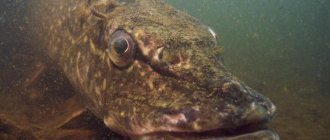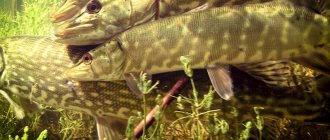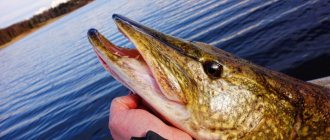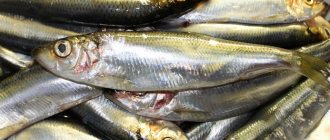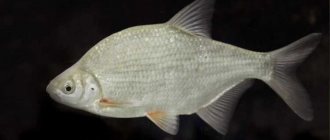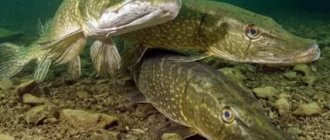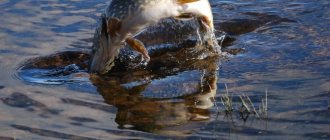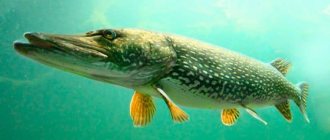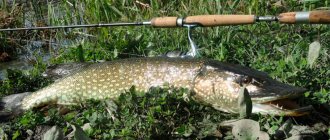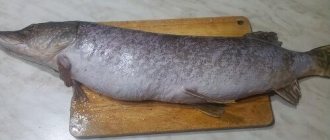The pike fish does not need any special introduction. We all know her very well, at least from children's fairy tales. And people have quite a few epithets for it - toothy, freckled, spotted, toad. However, what kind of toad is she? Some fairy tales and cartoons directly say that the pike is the daughter of the underwater king.
However, for us fishermen, such details of the family tree of the toothy beauty are not so important. We are more interested in that side of her life, knowledge about which contributes to her catching. That is, habitat, life cycles - spawning, timing of peak activity, or simply zhor, when and where it goes to rest, etc. Naturally, what is used to catch and what is the best bait for catching pike.
Habitat of species and habitat of fish of the genus Pike
Pike belongs to the Pike family with the only genus Pike. The genus includes 5 species, the distribution area of which is the water bodies of the Northern Hemisphere in North America and Eurasia.
Of these five species, 2 species live in the reservoirs of Russia and the republics that were once part of the USSR, now sovereign states - the common and Amur pike. There are 4 species living on the American continent:
- Common pike;
- American redfin;
- Muskinong;
- Black or striped.
The largest representatives of the genus are the Amur pike, the common pike and the muskie. American, or redfin, and black (striped) pike in nature do not gain weight more than 1.5 - 2 kg.
Ordinary
Amur (leopard)
Black
Muskinong
American (redfin)
Of course, having such a huge distribution area with a wide range of different living conditions, species in the course of evolution also have populations that differ in some morpho-ecological characteristics. In other words, subspecies. However, we will not touch them. What is important to us at the moment is the most common species living on our territory, dear to the heart and desired as a trophy - the common pike.
The freckle lives in virtually all rivers, lakes, ponds and reservoirs. Due to the fact that the fish is able to safely tolerate conditions with an oxygen content in water of 2-3 mg/liter and a somewhat acidic environment, it is often found in biotopes such as swamps and peat quarries.
For normal life activity, growth and development, it does not require a large species diversity of food items. Here in Siberia, sometimes there are reservoirs where pike is the only representative of the ichthyofauna. Or one or two other species of fish live next to it. In such cases, the toothy one has highly expressed cannibalism. Without serious human intervention, this does not prevent her from existing peacefully for a long time and producing fertile offspring.
The color of the predator can change depending on its habitat. Lakes with low-transparent water and silted bottoms are inhabited by fish of dark morphs. In reservoirs where the water is clean and transparent - gray-green or yellow, or brownish.
Also, the color of pike changes with age. Adult fish look darker compared to their juvenile counterparts.
Pre-winter habits of pike
All good things come to an end someday, including the autumn pike bite. However, the pre-winter state of the predator, and therefore the model of its behavior of the same name, does not at all imply poor biting or its absence. It’s just that now fishing is not autumn, but more winter. This means that the nature of pike behavior is completely different.
So, it is known that at this time the pike becomes extremely inert. Nevertheless, her appetite and desire to catch easily accessible prey do not disappear. So it turns out that smooth movements of baits in the immediate vicinity of the pike’s location will be in greatest demand. It’s just that in icy water the predator’s vital processes operate in economy mode, and the supply of nutrients should not run out ahead of time.
In terms of time, the pre-winter model usually occurs in November on closed reservoirs, and October-November on rivers. In principle, this is a kind of final transition in the underwater kingdom from autumn to winter. At this time, the majority of pike completely leave shallow waters and return here only for short periods of their activity. The toothy one spends the rest of its time in deeper and, as a rule, snagged places. At the same time, a significant part of the time the pike is still in a mood favorable for eating.
When fishing on ponds and lakes, you should look for the deepest areas and fish their edges. The most active fish will be “on duty” there. In reservoirs, it is not so much the maximum depths that are relevant, but rather the pits where the predator traditionally spends the winter. Usually it’s the same snag with schools of small fish.
The river suggests an even simpler option. The area where the maximum depth is guessed will be the most promising. This is nothing more than a wintering pit. And if it is not included in the list of places where fishing is prohibited in winter, then for a spinning angler this is the most fertile place. Often it is not the pit itself that gives the maximum result, but a nearby spit, a coastal creek, several reed bushes near the coastal edge, etc. Pike regularly come here to hunt.
The size of the baits should be quite large (about 4 inches), and the visual similarity to the food object in static and dynamic conditions should be maximum. The pre-winter model is not the best time for experiments. Personally, the proven Fishunter 3 inches, Onc'Up Shad 4 inches, Fish Tail Shad 2.8 inches, and Curly Grub 3.5 inches worked for me more effectively than others over the last two seasons.
When does pike start to spawn?
Pike spawn, as befits serious predators, earlier than the food item. By the time the larvae of other fish hatch from the eggs, the juveniles are already growing, which means they already have food for proper nutrition.
Leaving for spawning grounds occurs at a water temperature of 6 - 7 degrees. Therefore, in many northern regions, pike spawning begins under the ice.
That is, if we take into account the conditions in Western Siberia, the pike goes to spawning grounds in late April - early May.
Younger predators, up to 3-4 years old, come to spawn with the “first wave”. Large, adult fish spawn next.
Freckled fish becomes a sexually mature fish, depending on the region of residence, at 2 - 4-5 years of life. At the same time, it reaches a size of about half a meter with a body weight of 600 grams to one and a half kilograms.
These data are somewhat averaged, since much in the life, weight and size of a fish depends on the food supply, the temperature regime of the reservoir, and factors affecting its life activity (biotic and abiotic).
Spawning grounds are located in shallow waters flooded with water, well warmed by the sun's rays to a depth of 1.5 - maximum 2 meters.
During spawning, fish are united in groups, which include one female and (again, depending on the population structure) 2 - 7 males. Males, which is a feature of predators, are always smaller than females. According to ichthyologists, males larger than 10 kg were not caught. And with age, the percentage of the male-female population changes towards females.
You can distinguish a female pike from a male externally by the shape of the urogenital opening. In the female it is surrounded by a muscular ridge and has the appearance of an oval depression. In males, the opening is represented by an oblong slit.
Pike caviar is quite large. The diameter reaches 2.5 - 3 mm.
The amount of eggs spawned depends on the age and size of the eggs and ranges from 30 to 80 thousand eggs.
The most reproductive unit, capable of producing 100% healthy offspring with the maximum amount of full-fledged eggs, are females aged from 3 to 7 years. As age increases, the amount of complete eggs decreases; spawning does not occur every year (once every 2 years).
After a couple of weeks, larvae emerge from the eggs and at first live off the yolk reserves.
As they grow up, they begin to hunt for small crustaceans and small invertebrates (daphnia, cyclops). Pike larvae begin to show their cannibal abilities when they reach a size of 1 - 1.5 centimeters.
When they reach a mass of 4 - 5 grams and a length of about 5 cm, shorthorned nuts hunt for juveniles of other fish species that hatched later and are much smaller in size. Upon reaching a length of 10 cm, squirrels switch to a 100% predatory lifestyle. Their diet consists mainly of fry of other fish and their own kind.
Once, sitting with a float rod on the shore, I had to watch a small pike hunt for a long time. Having a length of 6 - 7 centimeters, the small fry quite quickly snatched small fry from the flocks of small fry floating past its ambush. He behaved as if he had been hunting for years.
Summer habits of pike
In the summer, two extreme models of behavior are clearly expressed: progressive (pike is active or semi-active) and inert (the predator is relatively passive).
Summer progressive habits of pike
Summer progressive is observed when the water has not yet had time to heat up to a high temperature (no higher than 20-22 ° C) or, on the contrary, has already cooled down to this level. This is usually early June or late August, but even in the middle of summer, a summer progressive pattern is common. The above is true both for rivers and for reservoirs with ponds and lakes. Maximum mobility is required from the fisherman at this time. The fact is that now the pike is very dispersed throughout the reservoir, and it is simply unreasonable to focus on one place. Often, even at a super-promising point there are approximately the same number of specimens as at most other sites. The maximum dispersion of pike is associated, first of all, with rapidly developing underwater vegetation. It is the grassy areas, as well as the territories adjacent to them, that are the most likely bite site. And since there are many such places in any body of water, it turns out that the fish are distributed as evenly as possible. I would call the most effective tactic in this case “gathering”, when the fisherman at a high pace simply fishes for possible predator ambush sites. And here the dependence is simple: the more casts and fished places, the more bites.
The summer progressive model is characterized by a slight predominance of wobblers over silicone. And if we talk about rivers, here, according to my observations, cranks are most effective, but on reservoirs without a current, minnow geometry is almost always the clear leader. And this is not the case when silicone or spinners have lost their relevance. Simply in terms of the ratio of “fishing pace” and “bait catchability”, wobblers are preferable. The first signs of the beginning of the progressive model are weather changes (cold temperatures or precipitation), calendar (nights become longer and cooler), temporary (the day before, pike pecked not only in the morning, but also during the day).
Summer inert habits of pike
As an alternative to the previous model of pike behavior at this time, the summer inert model appears. According to it, the pike still occupies the maximum territory, there is practically no competition between individuals, and due to the reduced content of oxygen dissolved in the water, the metabolic processes of the predator are quite slowed down. As a result, the bite is sluggish and short-lived. The first sign that the pike has switched on the summer inert model is a pronounced short morning bite and its almost complete absence in the afternoon.
On stagnant bodies of water, this pattern appears already in July and usually lasts until a noticeable cold snap in September. On rivers, as noted earlier, inert and progressive models constantly replace each other. Frequency: one to two weeks. It is completely wrong to believe that the summer inert model is unpromising for a spinner. Although the predator is sluggish, it still feeds at this time. This is especially evident on rivers.
To achieve success, the first thing is to gather your courage and decide to go fishing. It is better to be at the reservoir at dawn. You should not linger for a long time in one place, even if it is a hundred times promising. If we are talking about coastal fishing, then the priority is on the side of the jig, but if fishing is done from a boat, then the preference is with wobblers. Fishing with cranks is especially comfortable and appropriate at this time. The secret of success is obvious: without extra effort and at an excellent pace, we catch new and new places. This way we have the opportunity to meet the maximum number of active instances.
Pike
Preferred habitats
The behavioral characteristics and preferred locations of pike living in large rivers, lakes, reservoirs and small reservoirs are generally similar.
Young pike (grassfish) prefer to stay in the coastal strip. In thickets of plants, accumulations of snags and other areas with many shelters. With age, large fish begin to move to deeper places, stick to holes and pools, periodically going to the shore, to the edges, to the confluence of streams and rivulets to feed. Such exits are often timed to coincide with morning and evening dawns, and at night.
In rivers with a current, it prefers relatively quiet areas with a slow current, where there is an opportunity to hide - snags, boulders, rock deposits, underwater vegetation.
The largest individuals usually stay near the rifts, in the deepest places, and near the mouths of flowing rivers. Medium to small fish gravitate towards the shoreline.
The literature sometimes says that pike is a territorial fish. Ichthyologists studying the behavior of this predator have different data and opinions. Some adhere to this statement, others completely refute the existence of territorial dependence.
I don’t know how right I will be in my judgment, but I believe that pike does not have clear protected habitat boundaries. Its behavior consists of opportunities to occupy the most comfortable and promising places for hunting. The best areas are occupied by strong and large fish, and nearby, in somewhat worse conditions, there are smaller pike. As soon as the best snag is released (caught by a fisherman and eaten), it is occupied by another predator with a high status. Which, by the way, could be from the group that was nearby, or some kind of nomad in the pond.
How long do pike live and what size do they reach?
There are legends in literature about the fantastic size and enormous age of pikes. Boris Godunov's pike is 200 years old. The toothy Barbarossa, who lived at the “court” of Frederick the Second, was already 267 years old and had a mass of 130 kg and a length of 6 meters.
Whether to believe this data or not is a purely personal matter. I prefer registered copies. For example, according to official data, a 33-year-old pike was caught in Lake Ilmen on the territory of the USSR in the 1930s. It was about 2 meters long and weighed 35 kg.
Ichthyologists confirm the presence of larger specimens, up to 45 - 55 kilograms.
The largest pikes live in lakes in the north of the European part of Russia. And not in rivers, but in lakes. The further south the body of water, the less chance you have of actually encountering trophy fish.
Zhor, or feeding activity of pike
The feeding activity of pike is maximum at a water temperature of 13 - 18 degrees. In such conditions, it feeds most intensively, grows better and, as a result, is better caught with fishing baits.
When the temperature rises above 18 degrees. Celsius, pike activity decreases significantly. It is for this reason that in months of the year such as July and August, there is some calm in most reservoirs.
Hunting trips become short-term, they are timed to early morning, late evening and twilight.
In general, water temperature is the biggest factor influencing the bite. Even more than pressure. Pisces are cold-blooded creatures. All changes in temperature directly affect the metabolism in the body.
It would seem that as the temperature rises, the metabolism increases, food is digested faster, and therefore the duration of the hunt should increase proportionally. In reality, everything happens differently. Everything happens within a clear framework, a norm of reaction to changes in environmental factors.
At low temperatures, pike feed up to a certain point. When lowered, he falls into a stupor and stands in the pits.
At temperatures above normal, it also feeds, but after a short hunt it again goes deeper into more optimal conditions and stays there until a certain moment. It digests what it eats, breathes, becomes overgrown with leeches and no longer feeds. This picture is most common in closed, inland reservoirs.
On the rivers the situation is much better. There are rifts, areas with reverse flows, reaches, and holes. As a result, pike fishing on rivers continues even in hot weather. The main thing is to find places where pike escape from unfavorable conditions.
The thermocline also has a similar effect in summer. In autumn, when the temperature of the water layers has a strongly pronounced “storey”, the capture of trophy pike near the shore is quite understandable.
It is with the establishment of the optimal temperature regime, when “correct” digestion of food occurs, there is no oxygen starvation and the phases that fishermen call “pike zhor” are associated.
The main, mass outings for pike are typical before spawning, 2 - 3 weeks after and on the eve of freeze-up.
But even under ideal conditions, pike do not come out to feed regularly. Another factor comes into play here - the mass of prey eaten. If a predator dined on a large fish, which allowed it to absorb the energy spent on hunting and use it to build a body, then in this case the next active exit may be in a week.
When the toothy fish has managed to eat several fry, which have been digested in a short time, the fish goes in search of food much earlier. Maybe even a second time in a day. But even here there are certain exit hours, which are timed to a certain time of day, and each body of water has its own.
It is for this reason that there are situations when an angler comes to a pond and can confidently say that there is a pike here. He throws bait for a long time, almost hitting the fish on the head, but it doesn’t even react. The spinner leaves in despair, and after an hour or an hour and a half the pike “comes to life” and begins to eat.
For any fish in a designated reservoir, you just need to pick up a key and not rush to conclusions.
Large migrations and spawning
This is one aspect of preparation for spawning. In general, the preparation itself begins in August-September, when pikes begin their so-called contribution to reproduction. They begin to eat a little more (on average 1.1-1.3 times more for females), which is caused by the need to spend energy on the formation of ovaries. By the way, this is one of the reasons for the so-called autumn zhora and the reason for the greater likelihood of catching a trophy in the cold season.
On the other hand, migration is included. Typically, spawning migration begins somewhere in February-March. During this period, pike movements are massive and very pronounced. In lakes or reservoirs these changes can occur unnoticed, but on small rivers we can observe this in all its glory. And this movement is directly related to what we call pre-spawning gluttony.
There is no increase in appetite as such at this time, and the sudden increase in catches is explained by the large number of pikes. Pure mathematics comes into play here, when the number of catches grows in proportion to the number of pikes. And as you know, it is much easier to catch fresh migratory fish than sedentary ones. Here it is useful to remember about the learning ability of fish and the skills they develop to protect themselves from getting into trouble.
Sequence
However, not all fish start to spawning grounds at the same time. The general picture is this: males come to the spawning grounds several weeks before the females appear, then the females arrive and spawning begins.
But there are also particulars. For example, those males who lack the courage, intelligence or opportunity to eat normally are lagging behind their peers in growth. They also want to reproduce, but not become food. Therefore, they choose an interesting strategy - to come to the spawning grounds much in advance, before the main influx of males.
The smallest males come to spawning grounds at the border of autumn and winter, in November-December. Therefore, meeting a small pike at this time on a riffle (an intermediate point along the way), in a shallow bay or other spawning place should not be surprising. Of course, not every pike seen on a riffle is exactly like this, but it’s worth keeping in mind that it could be a male who decided to outwit everyone.
Distance
Knowing that the pike has homing, centers of activity and the ability to return to these centers, it is easy to guess that there may be some distance between these points. The question is - which one?
Actually, different. And these distances largely depend on the pike itself, its tendency to wander, the characteristics of the water system and, to a large extent, on chance.
Dry research numbers show distances from a kilometer to whatever happens. For example, in the Danish Gudeno River, some pike went to spawning grounds 37 kilometers from the place of capture. What is important is that this is not some huge water artery: by our standards, Gudeno is a small river and its total length is only 176 kilometers.
However, the longest transitions are typical for females. Males travel much shorter distances. For example, in the same Gudeno, the observed male pike individuals used spawning grounds relatively close to them. And the maximum recorded distance for them was only 10.3 kilometers.
The results presented are not unique. On the contrary, they are the most common and show the most average picture. After all, approximately the same figures were obtained in Ireland, the USA, Norway and many other countries where more or less detailed studies of this issue were carried out. In the meantime, the maximum recorded figure is 250 kilometers []. Yes, two hundred and fifty kilometers.
As for homing (when the pike purposefully returns to certain spawning areas), the exact ratio of fish that actually homing and those who use the closest spawning grounds is unknown. In different works you can find very different figures (usually 10-40%), but you need to understand that these percentages are taken from the observed sample. And in most studies it is very limited. Even in cases where 500 fish or more are observed, the relationship of homing pikes to all others will be unique in its own way. That is, it is not yet possible to confidently name the exact percentage of pikes that return to the same spawning grounds.
But judging by indirect evidence, taking modern observations and data from geneticists, we can assume that the percentage of homing pikes, although it may be significant, is unlikely to cover the number of pikes using random spawning grounds. In particular, a good example is the work of paleogeneticists who study the DNA of ancient organisms.
The pike, whose 8,800-year-old fossilized parts were found in Alaska, has descendants not only in Alaska itself, but also in Europe. Moreover, there are quite a lot of descendants. That is, the genes of this pike somehow slipped from North America through the then existing Beringia, got to Asia, and through the territory of modern central Russia came to Europe. And this to a large extent testifies to the ability of pikes to quickly populate new territories precisely due to the large number of individuals that do not use homing.
In other words, if the pike were really so sedentary and lazy, the geography of its distribution would not be as wide as we can observe. Moreover, it is very likely that the ability for long migrations saves an entire species from possible isolation and extinction due to random cataclysms. At least, pike managed to meet the appearance of large dinosaurs (and the northern pike personally saw tyrannosaurs), survive them and some subsequent cataclysms, such as global glaciations.
Unique phenomena
Running with obstacles
Moving is often difficult, especially in streams.
Initially, these were isolated logs, rubble, scatterings of stones and beaver dams. Now man-made barriers have been added to this: pipes and artificial embankments. Indeed, the presence of an obstacle in itself creates difficulties in the movement of fish. However, fish in general and pike in particular have learned to overcome them. In most cases, we can see beautiful footage of salmon jumping over a riffle and calmly rising further, unless a cunning bear is waiting for them at the top. But very few people know that salmon acquired this ability along with pike. Perhaps this ability was already present in the common ancestor of salmon and pike.
So pikes can jump over and even crawl over obstacles. And if earlier such information could be called into question, now we have at our disposal not only the words of eyewitnesses, but also photos and videos. True, so far this pike ability has been recorded only by civilians and has not been studied in detail.
Clusters of pikes. Party meetings
With at least two major seasonal movements on the schedule, it is inevitable that several pike will end up in one place. It is known that pike can be aggressive towards trespassers. However, in some circumstances, pike are quite tolerant of excessively close proximity.
Generally speaking, we can carry out a certain proportion and derive a criterion for the “friendliness” of pike in relation to its relatives. The more available food there is, the less cannibalism within the pike population. The similar size of fish also reduces the risk of cannibalism. Although at the same time, greater competition reduces the efficiency of hunting.
Thus, we can derive three main criteria that stimulate the emergence of party meetings:
- The closest sizes of pikes;
- Availability of affordable food in large quantities;
- “Bottleneck” on the migration route;
The last point stands out. Indeed, in some cases, a “bottleneck” on the migration route turns out to be the only reason for the accumulation of pikes in one place. And in this case, the first two criteria may not be met. For example, we may encounter fish that are noticeably different in size from the main mass.
Such accumulations most often occur at the entrances to narrow channels and at the mouths of rivers flowing into a reservoir or lake. Such accumulations in holes below an obstacle (bridge, dam, scattering of stones or cross pipe) are not uncommon, especially on small rivers and streams. The bottleneck effect is most pronounced during large seasonal migrations.
Worth reading: Pike in the grass
However, it is very important to keep in mind that possible aggregations are not an argument for the assertion that pike are a schooling fish. Pike do not lead a school lifestyle at any stage of their life.
To call a group of fish a school, criteria such as coordination of actions, the ability to destroy and restore the group must be met. Pike don't have this. And aggregations are random fish that have come together for completely different reasons. Moreover, these fish can be not only different sizes, but also different types.
Another option for the appearance of aggregations of pike may be seasonal migration—pursuit of forage fish. Thus, some fish (especially carp) can go to tributaries for the winter, and some pike leave after these fish. In addition, constant migration-pursuits are also known, when pike almost continuously follows a large school of forage fish. This is especially noticeable in the Baltic Sea, where pike are chased by large schools of herring.
Does pike bite at night?
It depends on what you count at night. I had the opportunity to catch pike during the white nights using surface baits. Not often, but it happened. At night, no pike can be caught. And no matter how they prove to me that they caught the predator with the light of a flashlight on its forehead and this happened more than once, I won’t believe it.
The activity of pike increases with the morning and evening dawns, as well as with the onset of twilight. Further fishing of the water area is futile. As soon as the solar disk completely disappears behind the horizon, the fish begins to behave differently.
Night bites of pike on the girder are rare. Although if you come across it, it’s usually a good specimen. As scientists explain, large, trophy fish come out at dusk to pick up dead fish. Not rotten and smelly, with decaying flesh, but recently fallen asleep. She will not actively chase or jump out from an ambush for prey.
Rare nighttime catches of large specimens with a dead fish or sleeping live bait can be compared with the moments when you go to fish for burbot in the fall, and in addition you come across a pike standing near the shore or in shallow water.
Fishing for pike with a spinning rod
Spinning pike fishing is considered almost the most popular type of fishing these days.
It's all about the special excitement, because even a small pike allows you to feel the whole essence of fishing. Even if for a good bite, you will change more than a dozen places and row more than one kilometer. The grip of a large pike allows you to understand that all the efforts spent were not in vain. Having competed for the trophy, you will feel an extraordinary surge of strength and increased tone, not to mention the physical activity that has a beneficial effect on your general condition. Naturally, during the spawning period, you should not disturb natural processes. It is best to catch pike with a spinning rod after spawning, about two weeks later, the fish begins to eat after spawning and active fishing will continue for another three weeks. In the summer, pike are reluctant to respond to lures, and fishing becomes quite difficult. With the onset of autumn, the active bite returns and continues until the water freezes. It has been noticed that in spring there are more bites near snags and driftwood, but in summer and autumn it will be important to look for pike on steep banks overgrown with vegetation.
In spring and summer, you should go fishing for pike with a spinning rod in the early morning; the fish are more active at this time. In autumn, fishing continues all day, here it is worth considering that at sunrise you need to cast and pull the lure away from the direction of the sun's rays; the predator does not like being blinded by light, and extraneous reflections contribute to losing sight of the pursued bait. Many wobblers and spinners can be effective, but it is still recommended to fish with spinners designed specifically for pike. The catchability of standard spinners increases if a small bundle of bright threads is tied to the tee. A good selection of spinners in reserve will be a huge plus for you. Live bait is considered no less effective, whatever one may say, but real fish look more appetizing!
The choice of rod for assembling spinning gear falls on medium weight (Medium / M), because you will have to make quite a few casts. It is equipped with an inertial reel with a line thickness of at least 0.5 millimeters, or an inertia-free reel with a slightly smaller line diameter of 0.3 millimeters. I equip the lure with a metal leash, but this is everyone’s business, there is a possibility of the fishing line breaking on the sharp teeth of a pike, but I don’t want to lose my favorite lure.
Fishing for pike with a spinning rod, as a rule, begins with casting; after the spoon hits the water, the fisherman can visually understand how long it takes for it to sink to the desired depth and then begin reeling. Uniform reeling rarely provokes the pike to attack; it is necessary to give the lure some kind of play or imitation of a wounded fish, for this purpose alternating twitches are made and the reeling speed is increased and decreased.
If this does not bring results, do not be upset, just change one lure to another and you will definitely succeed!
Does pike have its own territory?
Ichthyologists who specifically study the life and behavior of pike in nature have found that our common pike is not a territorial fish.
Of course, each individual living in a reservoir has a certain connection to the local territory. The pike moves along this area several times during the spring and autumn seasons. According to scientists, the length of such movements ranges from tens to hundreds of meters, depending on the type of reservoir.
“Travel” is associated with the food supply, the search for optimal oxygen and temperature conditions.
In situations where anglers come across fish with traces of cuts from teeth, lacerations are more likely to confirm the flourishing of cannibalism in pike. But this has nothing to do with active protection of the territory.
Toothed animals, within a certain local area, have their own hierarchy. The largest and most powerful predators occupy the most promising places - boulders, snags, ledges of the coastline and aquatic vegetation. That is, those points that we, fishermen, try to find on a body of water.
As soon as the pike that occupied the strategic point is removed, the next, largest and strongest contender enters the vacant place.
But what about the skirmishes between pikes, about which information will leak out? What's wrong with that? Driving an opponent away from their habitat and feeding area is a completely natural situation in the living world.
Moreover, such an action is often not required. According to scientists, pikes have a highly developed sense of smell. As a result, if we also link here the presence of a strict hierarchy, then an obviously weak fish does not need to provoke the wrath of a strong opponent and receive lyuli for failure to comply with the rules of behavior in pike society.
Another example of the absence of strict territorial behavior in pike is the formation, even short-term, of communities.
This applies to relatively young individuals, since large predators prefer a solitary lifestyle. Collective hunting, driving a school of fry or attacking one large prey is also not observed in pike.
And if we sit down to remember that sometimes spinning anglers manage to get to a pike party meeting, then the conclusion is that only one bites. By the way, at these mass gatherings pike of different sizes and ages gather in a small area.
In principle, the presence of a large number of pikes, sometimes large ones, in a small area can also be explained by the presence of optimal conditions for life, under which there is enough space and food for everyone gathered. At the same time, there are no visible reasons for being aggressive towards relatives.
Habits from childhood
In the article about two forms of perch, an example was given of the division into active and passive individuals. The difference in the scale of movement, the size of the fish was shown, and the difference in nutrition was indicated. For perch, the easiest way would be to attribute the difference in growth rate and timidity to diet. They say that the predatory fish-eating perch receives more calories per unit of time than its relative, which eats invertebrates in the grass.
But correlation is not causation. If we look at other species of animals, where there is also such a division into bold and timid, it turns out that the type of food for many of them is absolutely the same. Moreover, some species cannot make much choice, since millions of years of evolution have left their mark even on nutrition.
A great example is cats. They have initially bold individuals (they can be identified almost immediately after birth) and initially cautious ones. But at the same time, different cat personalities do not differ in food preferences. And all because cats are strictly obligate predators. That is, those who support an exclusively meat diet. A cat can eat anything, but its body will function normally only on meat. So if, during a pasta diet, the cat actively shits in his owner’s shoes, this will be fair retribution for the wrong food.
It’s exactly the same with pike; it is also an exclusively meat predator. But most likely he won’t shit in his slippers. And the difference in nutrition among perches with different “characters” stems from facultative predation. In other words, bass don't need to eat only fish—worms and leeches will work, too. The only difference in the feeding habits of different pikes may be selectivity. For example, shy pike may be less enthusiastic about attacking large prey, preferring prey sizes that can be “sucked in” as quickly as possible. More details about this were in Shchuk’s article. Size hierarchy, cannibalism, food theft and other pranks.
However, already at an early age, pikes begin to discern differences in character. And around the end of the first year of life, we can quite confidently identify bold or cautious individuals. Moreover, this manifests itself not only in behavior. Some pike go to live in specific areas that differ significantly from what we call the lace kingdom.
The fate of such pikes will develop differently. First of all, a difference in height will become apparent at the very beginning. Those pike that go into open water begin to grow faster and generally gain good physical shape. For example, it is very beneficial for males of such pikes to be larger in their age group. Simply because they can subsequently perform reproductive functions better and at the same time risk less to their health.
However, this is a long term perspective. But apparently such delayed benefit greatly outweighs the risk of mortality. True, it is still unknown what exactly makes some pikes leave comfortable places. There is an assumption that this is the result of the displacement of such pikes from internal competition for resources within the “incubators”.
Sedentary and migratory pikes
Perhaps this is where the primary division of pikes into homebodies and travelers comes from. And some variety in the pattern and distance of migrations may also be the result of the very first “choice” - to go into open water or sit in the grass. Ultimately, two groups of pike emerge from one spawning: resident and migratory.
The sedentary ones remain in the spawning area (in the broad sense: small rivers, streams, floodplain lakes, bays, etc.) and live there all their lives, making up the indigenous population. There is an opinion that the majority of sedentary fish. Those fish that we meet in very small rivers in summer, autumn and early winter are just like that, sedentary. Moreover, sedentism is not always associated with the small size of fish.
Migratory fish only use spawning grounds, and after spawning they migrate back to larger bodies of water. However, some of these fish can remain in the spawning area in the summer, but still go into deep water for the winter. We often see such pikes on the same small rivers in spring and late winter. And it is precisely because of them that we can get to the so-called pre-spawning feast, when in a very small river there suddenly becomes a lot of pike, including quite a decent size. Decent relative to the river, of course.
From this we can draw two preliminary conclusions.
- The larger number of sedentary fish suggests that the general tendency among pikes is to be relatively inactive. And this is a good argument in support of the concept “pike is a typical ambush predator.”
- The presence of pikes with different physical activity among one generation explains the relatively rapid (3-5 years) restoration of rivers after defishing. Of course, subject to a number of reservations. However, the mechanism for maintaining and expanding the population and species as a whole should not be underestimated.
Home territory
The big picture
The understanding of the term “settlement”, the regular mention of the territoriality of pike and the many evidence of repeated catches of the same fish from the same point hint at the need to clearly indicate this territoriality. These are the boundaries of pike settled life. Ideally, we want to get a specific and unambiguous “from now to now” with a list of externally readable features. But in fact, there are no strictly defined borders, strict territoriality, or even more specific signs. There is something else, more complex and ambiguous.
For rivers, we can easily explain the blurring of the proposed territory by the variability of habitat conditions. The water rose, fell, the flow increased in winter or almost stopped in summer. In our understanding, these factors easily break the paradox of a territorial pike without its own territory. But for closed systems, especially lakes, we are more inclined to believe in the existence of strict and long-term points where there will be no pike only if it is removed.
In fact, in both water systems, the territories and, moreover, their boundaries are greatly blurred. The only difference is that in a river it is easier to identify potential point segments of such territories. And, apparently, it is on these point segments that we most often come across resident pike. Since it is known that pike, for one reason or another, quite actively use connections to the terrain and vegetation, it is not difficult to identify such points.
Interestingly, nomadic fish are likely to occupy limited territories if they are moved to non-residential areas of the river. However, such fish try to hold points only in those areas where there are not a large number of other migratory fish. And this is quite logical, because in rivers the division into populations (sedentary and migratory) is more likely due to the smaller amount of food and suitable areas than in the lake []. And although this is known from studies of trout, we should not forget that pike and trout are very close relatives. And the conditions in the river are basically the same for all predators.
Worth reading: Large pike in floodplain lakes: where to look and what to think about
Migratory fish are very likely to pass by us, using the “obvious” places only for a short time. And we call a meeting with one or several pikes on a bare fast riffle at the end of November (when migratory pikes go into deep water) or February (when pikes, on the contrary, rise to the spawning grounds) an accident. In principle, this is how it is. Our meeting with such pikes and in such circumstances most often occurs by chance due to strong stereotypes regarding the seasonal characteristics of pike fishing in small rivers. But the very presence of pike in such places still has some pattern.
However, some observations shed some light on the issue of home territories. However, I must warn you that the information presented below must be used with extreme caution, since it was collected on small samples and individual statements are on the border of statistical significance.
The only thing is that we can sometimes observe some relationship between the size of the fish and the size of its territory. That is, the larger the fish, the larger the territory under its control. It is likely that we are talking about pure physiology here: a larger body size allows you to swim better and further.
Field research results
Home range
The earliest observations were often based on theoretical concepts. For example, for a long time it was believed that pike are, in principle, prone to a sedentary lifestyle. Consequently, it occupies some point or area, and sits there almost all its life. True, how such a site is chosen, why such sites in reservoirs without a current are sometimes located far from spawning grounds, and how the pike gets there is kept silent.
But somewhat surprisingly, the relative sedentism was confirmed with the advent of radio beacons and echolocation. And quite significant confirmation was the work of the late 60s and early 70s done in the USSR on the Rybinsk Reservoir []. They indicated that pikes have a strictly limited territory with a size of 50-150 meters for a flat bottom, beyond which they practically do not go. But in the area with the old riverbed, such an area grew up to 500 meters.
These works are implied (even by those who do not know about them) when talking about the movements of pike. Because some people, who by virtue of their position are invited to fishing educational interviews, continue to rely precisely on the works indicated in the footnote, answering the question “how far does the pike walk.” But there were already problems with the research at the time of its conduct that did not allow us to consider the results obtained as general for all pikes. First of all, because of the amount of time that was spent on field observations - 50-60 hours. And in one of the works the observation period is not indicated at all. But even the marked 50-60 hours is too short. Why is that?
Because from some recent studies, often not related to migration, we know that the feeding and locomotor activity of pike are not interdependent. This means that an actively moving pike may not eat, and an actively feeding one may almost stand still. In our fishing life, we often come across something like this when we catch a pike, and it’s all hung with bunches of leeches. At the same time, pike could be very active in terms of feeding behavior. And she collected leeches on herself precisely because of standing in place, which happened the day before. And at different times everything turns out differently: today the pike is actively swimming, and tomorrow it stands still.
Thus, the research carried out could have been carried out precisely during such a period of time when the pike was inactive. In other words, it just happened, an accident. But fortunately, other observations were also carried out (hot on the heels or for a completely different reason) with a more qualitative approach to the methodology and using long periods of time. And here the picture turns out to be clearer.
One of the first relatively large-scale observations was made in Canada in 1977. The goal was to double-check the statement about home territories, and at the same time establish the difference between the winter and summer positions of pikes. The main conclusion: it is not possible to identify strictly limited areas. In fact, pikes occupy all the most favorable space for life.
Moreover, during the study process, which took 47 days, it turned out that all the observed pikes walked quite freely. Some of the fish covered distances of up to 4 kilometers during the day, and the average distance was slightly less than a kilometer per day. For pike there was no big difference between summer and winter routes. The only difference is that in winter the pike stayed, on average, a little further from the shore. Perhaps this was due to fairly thick (75 cm) ice, which could partially block access to some areas.
Interestingly, distance records were set mainly in winter. Although there is a suspicion that this is due to pre-spawning migration. Of course, the pike was not constantly in motion and had occasional periods of rest, but no details were provided on this matter.
Activity Center
After this and several other similar studies, it turned out that the term home range, originally applied to mammals, is very poorly suited for fish in general and pike in particular[]. Because fish, unlike mammals, demonstrate more temporary range boundaries. In addition, in some cases it was reported that pike change habitats annually. For example, during the spawning period or, as described in the previous chapter, daily. Therefore, the term home range was replaced by center of activity.
In general, this topic itself caused a lot of controversy. In particular, due to the nature of many experiments: the fish were marked and released in the place where they were caught. In this regard, some researchers have stated that all these areas with centers are just the result of random settlement. Well, those experiments where marked fish were released in a very different place were few in number.
An interesting experiment was in the small (25 ha) German lake Kleiner Döllnsee, which is closed to any type of fishing and is used only for research purposes.
Here it turned out that if you catch a pike at point A and release it at point B, after a very short time (4-143 hours) it will return back to point A. However, no connection was found between the duration of the return and the size of the fish. But accumulations of pikes and their retention of certain territories were noticed. It is interesting that the winter activity centers were larger than the summer ones, and the differences between the locations of these centers were not particularly noticeable. Of course, there were pikes that greatly changed their position in winter, but in general the same places were used.
The initial explanation for the larger size of the winter activity center was that it was due to spawning migration. However, this assumption was later discarded as untenable. Argument: progress was made in February, but spawning occurred only in April. But the version where the increase in the size of territories occurs due to the destruction of grass areas looks more plausible. That is, the grass dies off, food fish stop using it, and pike have nothing to do there either.
However, it remains unknown what exactly causes the pike to return to its starting point. There is a general hypothesis that an animal never acts for nothing and there are reasons for everything. Returning to the center of activity, sometimes across the entire lake, should carry with it such benefits that it will outweigh the risks during the journey. However, in that lake, pike was the dominant predator, and there were few very large fish (80 cm or more). Therefore, the risk in this case seems to be minimal.
But there is another version, according to which pikes leave a “dangerous” place if they see the so-called agonistic behavior of other pikes. In this case, it can be assumed that they will add a “marker” to their cognitive map that associates this location with danger.
As for the size of the center of activity, although we can sometimes trace some dependence on the size of the pike (larger fish ⇒ larger area), in general the size of the territory depends more on the size of the reservoir. Thus, for the lake from the study discussed, the area of the summer activity center was 1392.5 m² in summer and 3612.5 m² in winter.
These numbers are very small, but they can be even smaller or even larger. For example, in a lake with an area of 4.5 hectares (this is a puddle of approximately 100 * 450 meters), repeated captures of pike in most cases occurred within 100 meters from the release site [] . In fact, the pike hardly moved here.
Worth reading: How fish swim
For rivers the situation is somewhat different and there is no direct relationship between the size of the center of activity and the size of the river. Thus, in one of the studies (and not only this) it turned out that river pikes use very small areas, on average 157 m². And this figure agrees well with the previously described uneven distribution of resources in rivers and lakes.
Between rivers and lakes there are reservoirs, which in their structure and functioning are in the interval between one and the other type of reservoir. Surprisingly, pike in reservoirs also use an intermediate life option. In reservoirs, pike move less than in lakes. And the theoretical centers of activity in reservoirs are smaller than lake ones, but larger than river ones.
Thus, all studies conducted indicate the creation of limited centers of activity by pikes. However, it is not yet possible to make any generalization for different water systems.
